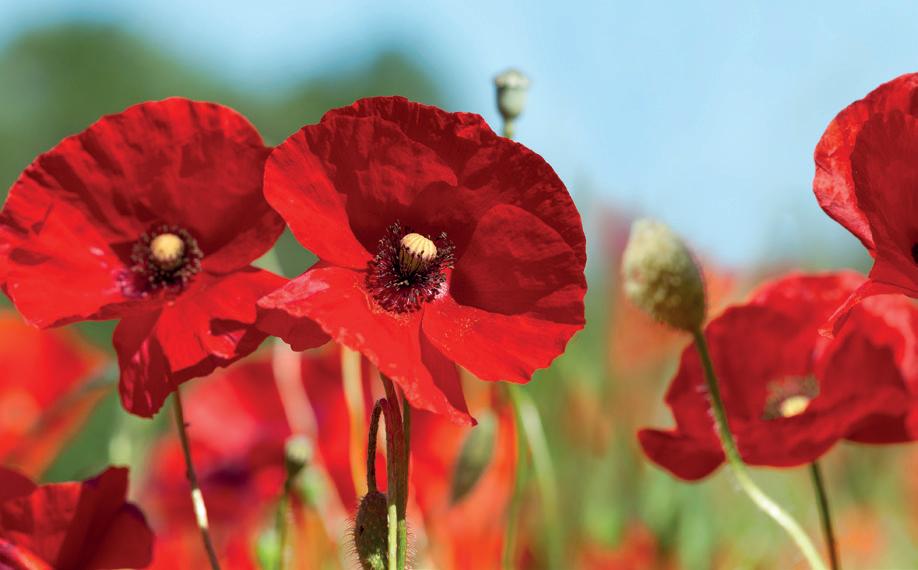
4 minute read
100th Anniversary of
from Village Tribune 128
ALL MAKES OF CARS MOT TESTED

Advertisement
For vehicles in Class IV (up to 3000kg)
We test, but don’t repair, so your MOT will be conducted in your best interest Mon to Friday: 7:30am – 5:30pm Saturday: 7:30am – 12:30pm T: 01733 810 288
E: nbsanders@btconnect.com N B SANDERS Werrington Bridge Road Newborough, Peterborough PE6 7PR

100TH ANNIVERSARY OF THE ROYAL BRITISH LEGION
The Royal British Legion, which has been supporting Service men and women, ex-serving personnel and their families since 1921 was formed on 15 May 1921, bringing together four national organisations of ex-Servicemen that had been established after the First World War: The National Association of Discharged Sailors and Soldiers The British National Federation of Discharged and Demobilized Sailors and Soldiers The Comrades of The Great War The Officers' Association
The amalgamation of these diverse bodies can be attributed largely to two men: Field Marshal Earl Haig and Tom Lister of The Federation of Discharged and Demobilized Sailors and Soldiers. Lord Haig served as the President of The RBL until his death. As a result of the war, Britain's economy plummeted and in 1921 there were two million people unemployed. Over six million men had served in the war. Of those who came back, 1.75 million had suffered some kind of disability and half of these were permanently disabled. Then there were those who depended on those who had gone to war – the wives and children, widows, and orphans, as well as the parents who had lost sons in the war, on whom they were often financially dependent. The Royal British Legion was established to care for those who had suffered as a result of service during the First World War. And has been helping the Armed Forces community and their families ever since. It is the country’s largest Armed Forces charity, with 235,000 members, 110,000 volunteers


ANNIVERSARY OF THE ROYAL BRITISH LEGION
and a network of partners and charities; helping to give support wherever and whenever it’s needed. The red poppy is a symbol of both Remembrance and hope for a peaceful future. Poppies are worn as a show of support for the Armed Forces community. The poppy is a well-known and well-established symbol, one that carries a wealth of history and meaning with it. Wearing a poppy is still a very personal choice, reflecting individual experiences and personal memories. It is never compulsory but is greatly appreciated by those who it is intended to support. But what is the inspiration and history behind the poppy becoming a symbol of Remembrance? During WW1, much of the fighting took place in Western Europe. The countryside was blasted, bombed and fought over repeatedly. Previously beautiful landscapes turned to mud; bleak and barren scenes where little or nothing could grow. There was a notable and striking exception to the bleakness - the bright red Flanders poppies. These resilient flowers flourished in the middle of so much chaos and destruction, growing in the thousands upon thousands. Shortly after losing a friend in Ypres, a Canadian doctor, Lieutenant Colonel John McCrae, was moved by the sight of these poppies and that inspiration led him to write the now famous poem 'In Flanders Fields'. The poem then inspired an American academic, Moina Michael, to adopt the poppy in memory of those who had fallen in the war. She campaigned to get it adopted as an official symbol of Remembrance across the United States and worked with others who were trying to do the same in Canada, Australia, and the UK. Also involved with those efforts was a French woman, Anna Guérin, who was in the UK in 1921 where she planned to sell the poppies in London. There she met Earl Haig, the founder, who was persuaded to adopt the poppy as the The Royal British Legion emblem in the UK. The The Royal British Legion then ordered nine million poppies and sold them on 11 November that year. Those poppies sold out almost immediately. That first 'Poppy Appeal' raised over £106,000 to help veterans with housing and jobs; a considerable sum at the time. In view of how quickly the poppies had sold and wanting to ensure plenty of poppies for the next appeal, Major George Howson set up the Poppy Factory to employ disabled exservicemen. Today, the factory and the warehouse in Aylesford produces millions of poppies each year and volunteers distribute 40 million poppies. The demand for poppies in England continued unabated and was so high, in fact, that few poppies actually managed to reach Scotland. To address this and meet growing demand, Earl Haig's wife Dorothy established the 'Lady Haig Poppy Factory' in Edinburgh in 1926 to produce poppies exclusively for Scotland. Over five million Scottish poppies (which have four petals and no leaf unlike poppies in the rest of the UK) are still made by hand by disabled ex-Servicemen at Lady Haig's Poppy Factory each year and distributed by our sister charity Poppyscotland. Today, 100 years later, the Poppy remains a symbol of Remembrance and Hope.










